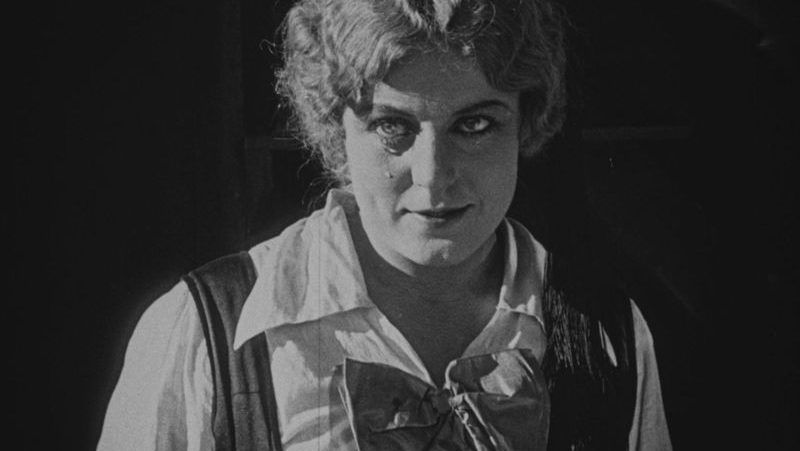Wednesday 5 October the Norma Talmadge retrospective continues with Yes or No,
and from the section “Venice 90”, Biały Ślad (The White Trail, 1932), which represented Poland at the first Venice Film Festival (Mostra Internazionale d’Arte Cinematografica).
A tour of the world in one day. The Giornate del Cinema Muto presents a kaleidoscope of places and images shot in many countries and continents. The most important rendezvous of the day for Wednesday 5 October, the evening show at 21.00 in the Teatro Verdi, takes us to Iceland, with Saga Borgarettarinnar (The Saga of the Family of Borg, aka Sons of the Soil, 1920) by Gunnar Sommerfeldt. The epic story of a family over a period of 20 years is a Danish megaproduction fittingly lasting almost 3 hours, shot entirely in Iceland using a Danish and Icelandic cast. Marking the beginning of film production in Iceland, it is based upon the debut novel of Gunnar Gunnarsson (who was later nominated several times for the Nobel Prize); the author also has a small role in the film. Greeted lukewarmly at its premiere in Copenhagen, The Saga of the Family of Borg was an immediate triumph in Iceland, where it is still shown in cinemas and on television. To celebrate the film’s centenary, the Icelandic National Archive, the Gunnar Gunnarsson Institute, and the Cultural Association Akureyri have curated a digital reconstruction in high definition for the Giornate. The composition of a new musical score was a big challenge for Thordur Magnússon, who has chosen to employ many diverse styles, from post-Romantic to Baroque, to Icelandic folk music and Lutheran psalms. The score was originally intended for a full orchestra, but taking into account that in the period that the film was released in Iceland full orchestras were rarely used, in the end for the Giornate event the composer opted for a core 9 elements from the Orchestra San Marco of Pordenone.
In the section on amateur cinema, “The IAC World Tour”, at 9.00, the short To Egypt and Back with Imperial Airways (1931-1932) naturally takes us to Egypt. The film is the work of Ruth Stuart, an English prodigy who shot this footage when she was only 16, travelling alone, and on a trip purportedly unknown by her parents. In 1933 the film won various international competitions for amateur filmmaking, and throughout the 1930s Stuart’s productions continued to win important awards.
In the section “Venice 90”, at 14.00, we go to the mountains of Poland for Biały Ślad (The White Trail, 1932), which represented Poland at the first Venice Film Festival (Mostra Internazionale d’Arte Cinematografica). It was directed by Adam Krzeptowski, a skiier and journalist in the 1920s who opened a photographic studio and soon dedicated himself to the making of documentaries exalting the beauties of the Tatra Mountains and the region around Zakopane. The White Trail is his most ambitious work, and it took him two years to make, an exceptionally long time by the standards of the Polish film industry. The plot hinges on a love story, but this is not the strong point of the film, as the actors were not professionals but sports friends of Krzeptowski. The quality of the film is due to the splendid photography of the beauty of the mountain landscapes, and the novelty of the daring shooting of winter sports – the footage was appreciated everywhere, and also used in other films.
Norma Talmadge is present once again in the programme of Wednesday 5 October at 11.30 with the screening of Yes or No (1920), yet another example of the actress performing a dual role, this time playing both a rich woman and a poor one. The film allows Talmadge to show off various clothes that were the height of fashion. Talmadge and her clothes will be the subject of a lecture on Thursday 6 October by fashion historian Michelle Tolini Finamore, introduced by costume designer Deborah Nadoolman Landis.
Also on Wednesday 5 October, at the Ridotto of the Teatro Verdi at 17.00, the annual Jonathan Dennis Memorial Lecture, dedicated to the memory of the founder of the New Zealand film archive, will be given by Stella Dagna, on the theme The Ethics of Restoration: Secrets and Lies.
A complete session of the Collegium, at 13.00 in the Ridotto of the Teatro Verdi, is devoted to Norma Talmadge, a diva now being rediscovered.
Also in the Ridotto of the Teatro Verdi, at 16.00, the theme of today’s FilmFair presentations by authors is slapstick comedy, with a book by comedy historian Steve Massa that unearths actors and directors of classic American slapstick, as well as a brand-new biography by James Curtis of the iconic Buster Keaton, master of the visual gag.
The online festival programme, on MYmovies, at 21.00 presents Kralj Aleksander na Bledu (King Alexander’s Visit to Bled, 1922) by Veličan Bešter and Po Horách, Po Dolách (Over Mountains, Over Valleys, 1930) by Karel Plicka.
The Giornate del Cinema Muto festival is realized thanks to the support of the Regione Autonoma Friuli Venezia Giulia, the Ministero della Cultura – Direzione Generale Cinema, the Comune di Pordenone, the Pordenone-Udine Chamber of Commerce, and the Fondazione Friuli.


 Italiano
Italiano
Recent Comments